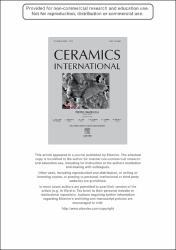Colloidal stability-slip casting behavior relationship in slurry of mullite synthesized by the USP method
Citation
Gören R., Ersoy B., Özgür C., Alp T. “Colloidal Stability-Slip Casting Behavior Relationship in Slurry of Mullite Synthesized by the USP Method” Ceramics International, 38 , 679-685 (2012).Abstract
This
study presents the outcome of a research concerning the relationship between the colloidal stability of mullite powders synthesized by the
USP
(ultrasonic spray pyrolysis) method and its slip casting behavior. The colloidal stability of mullite slurry has been investigated under three
different
pH conditions (4.5, 8.9 and 10.9) derived from pH-dependent zeta potential (ZP) curves. Employing these pH values, mullite slurries with
50
wt.% solid content were prepared and slip cast. The microstructures of dried and sintered specimens were examined using SEM. It is concluded
that
the pH significantly influences the stability and in turn the slip casting behavior of the mullite slurry. In order to prepare homogeneous and
stable
mullite slurry for efficient slip casting it is preferable to utilize a basic rather than an acidic medium. High pH (i.e. 10.9) tends to leads to more
closely
packed mullite particles resulting in a homogeneous microstructure and greater structural integrity.



















